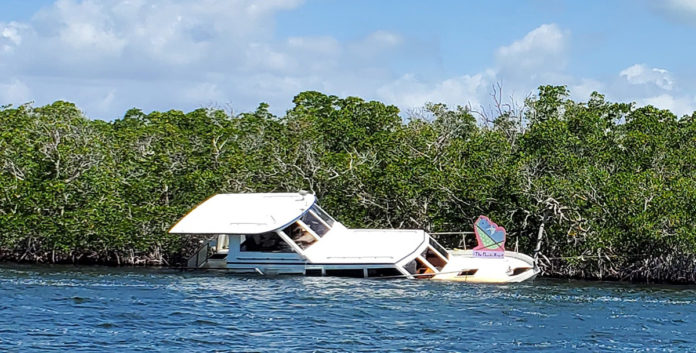Thirty-four derelict vessels have been removed from the waters off the Florida Keys since the start of 2021. Roughly 60 vessels that’ve been junked and abandoned will be removed by year’s end through a multi-agency effort.
With frigate bird sightings and dolphins seen swimming alongside boats also come views of marvelous mangroves and eye-opening water clarity, if conditions allow. However it’s also common to witness severely damaged boats submerged along the mangroves or floating in navigational waterways.
Combatting derelict vessels left by their owners is no easy task, taking manpower and money. And it doesn’t involve one agency, but several.
Florida Fish & Wildlife Conservation’s Jason Rafter heads up derelict vessel enforcement out on the Keys’ waters. Derelict vessels are those left stored or abandoned and in a wrecked state or substantially damaged condition. Vessels are defined under state law as watercraft that provide a means of transportation on water.
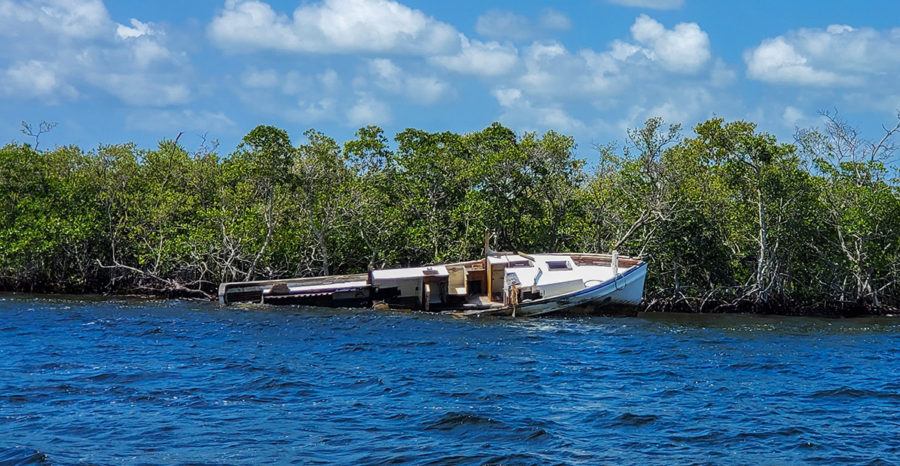
Rafter, in an interview with the Weekly, said an ugly vessel isn’t necessarily a derelict vessel. When a derelict vessel is spotted, however, FWC’s work begins to identify and investigate the last known address of the registered owner.
“Once we get the ID of the owner, we have to find that individual,” said Rafter, a 15-year FWC officer who has spent the last 10 years as the head supervisor of the derelict vessel program in the Upper Keys. “If they’re here in Monroe County, we physically go there. If they’re out of county or state, we send derelict vessel rights packages to that address.”
Rafter said a third of derelict vessels go back to Monroe County addresses, with the remaining two-thirds out of county or state.
“We also look in jails if an owner is not on board. That’s pretty standard,” Rafter said. “We recently found one derelict vessel in Islamorada, and we found the owner to be a woman who was in an Ocala County jail.”
A derelict vessel spotted recently on the oceanside at Rodriguez Key posed a navigational hazard. Checking the numbers on the boat, Rafter reached out to the Coast Guard to see what they knew.
“They got back to me and said they spotted that in Naples 30 days prior,” he said.
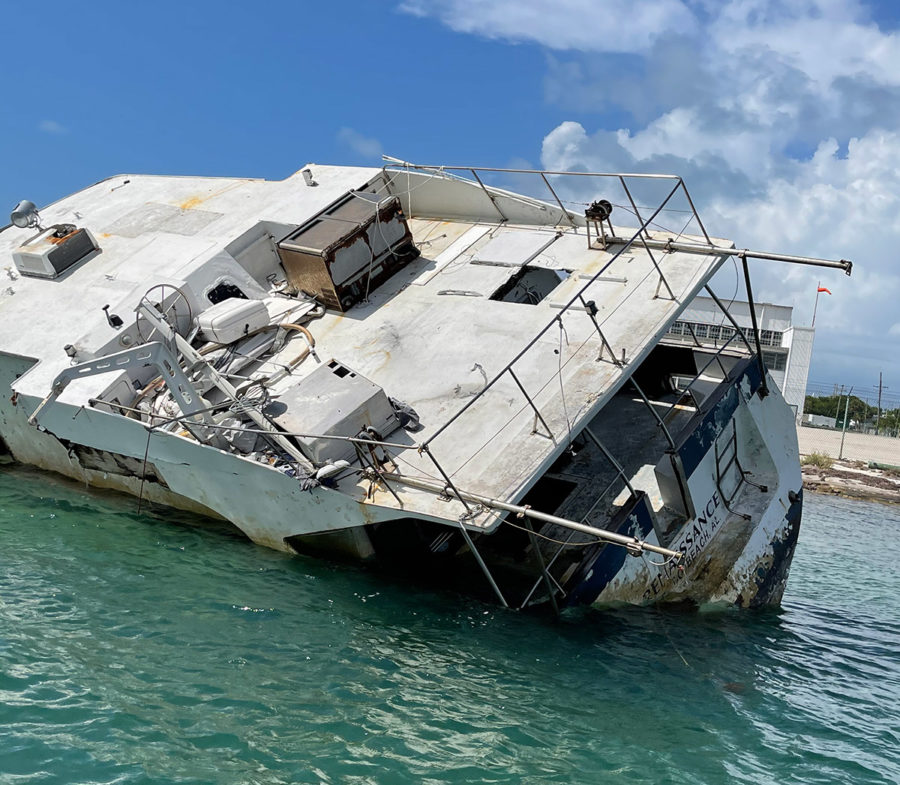
Once owners are found, they’re not only charged with a first-degree misdemeanor, but they’re also forced to pay back removal costs. Finding the owners is no easy task, however.
“It’s not unusual for us to track down three ‘owners of the boat,’” Rafter said. “The law requires you to notify the Department of Highway Safety and Motor Vehicles that they sold their vessel within 30 days of the sale. And vessel buyers also have 30 days to transfer the title.”
FWC investigators worked diligently in identifying the owners of two derelict vessels, one a 55-foot boat and the other a 33-foot boat a few hundred yards apart on Lake Surprise in Key Largo. Investigators weren’t able to find the owner or responsible party.
Vessel removal authorization forms were sent to the Monroe County Marine Resources Office. The two boats were eventually taken out of the water and dismantled. The cost? $27,500.
“These two were removed and I swear two more were replaced. There are times when it feels like you’re holding back the tide with your hands,” Rafter said. “Any individual officer in the Upper Keys could make derelict vessels a 20-year career. In Marathon, it could be 25 years. The further down the chain, the more DVs you get.”
Celia Hitchins serves as senior administrator for the county’s marine resources office. Once FWC exhausts all options to hold the derelict vessel owner accountable, they’re referred to the county marine resources and requested for removal. On average, the removal of 60 derelict vessels a year equates to about $238,000. Around $2.6 million was spent to remove derelict vessels between 2010 and 2020.
“We use Boating Improvement Funds, generated from vessel registration fees, and/or grant funding from the state to pay for these removals,” Hitchins said. “We have ongoing contracts with pre-qualified marine contractors to handle removal and disposal activities.”
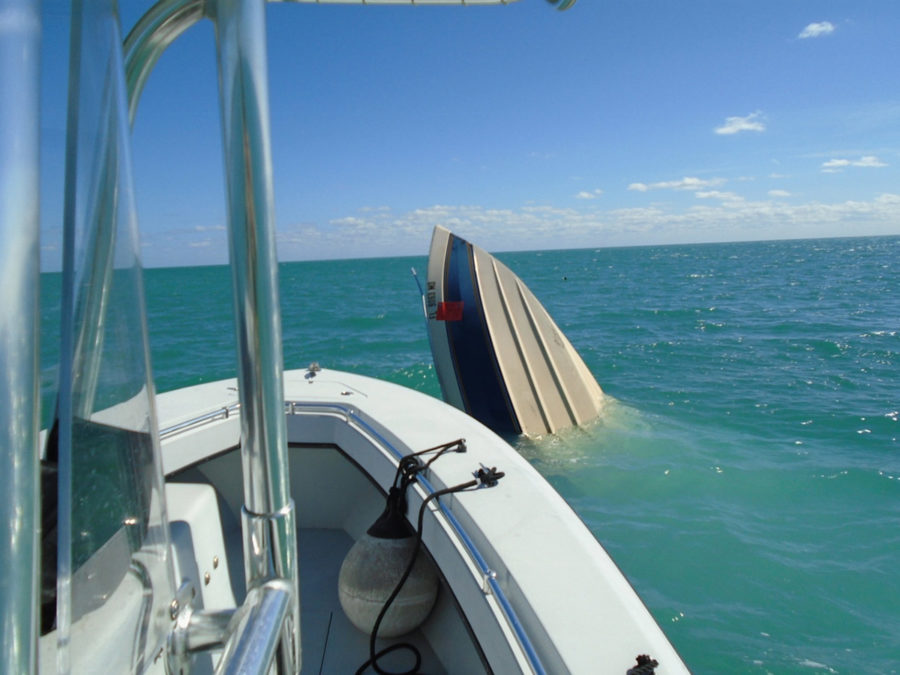
Vessel owners must repay the removal cost within 30 days, or else they lose the ability to register or renew a vessel or vehicle until repaid. In fiscal year 2020, the county received around 5% reimbursement from repayments.
“It’s been a mildly effective tool to reduce our total cost,” Hitchins said.
State funds to remove derelict vessels became available starting in 2019. In the past 12 months, approximately $340,000 in supplemental funding was provided to Monroe County. That’s allowed the county’s Marine Resources Office to fund additional removals and free up funding for other important boating-related services.
A historical analysis from 2008 to 2013 shows around 50% of derelict vessels were removed from the Lower Keys, mainly Key West and Stock Island. The other half is split between the Middle and Upper Keys.
Monroe County Mayor Michelle Coldiron and Brittany Burtner, county marine resources worker, recently joined FWC Commissioner Robert Spottswood, FWC Capt. David Dipre and officials from Key West and Marathon to scope out derelict vessels in the Key West area. Coldiron said the trip allowed her to view the different stages derelict boats are in, as well as the fact that some are not inhabited and mainly used for storage.
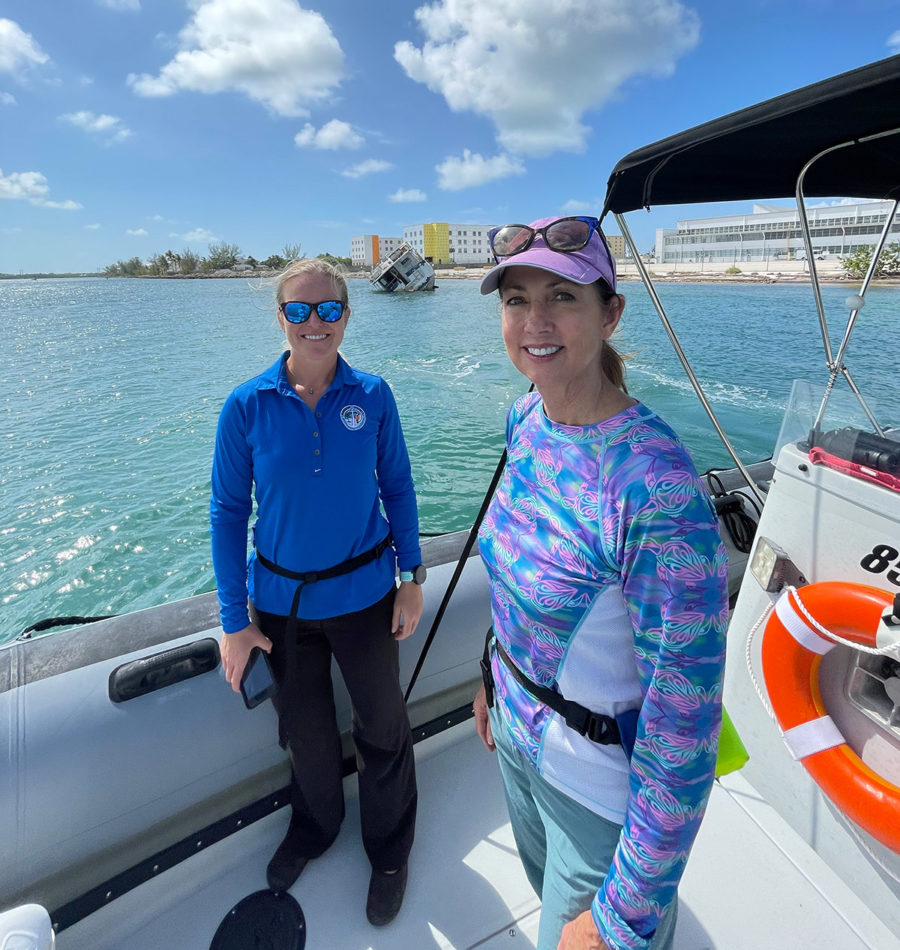
“Derelicts are definitely a problem,” she said. “When you have boats not properly anchored and storms come, they break free and roam and cause damage. The goal is to get derelicts off the waterway, which improves the quality of water and safety for all.”
Coldiron said officials also examined mooring sites following a state bill that requested 300 more mooring buoys. It doesn’t go into effect until the county approves, permits and opens new moorings for public use, at least 250 moorings, within a mile of the Key West Bight City Dock and 50 at the Key West Harrison Bight Mooring Field.
“FWC wanted us to come out and look and see where mooring balls could be placed. Do we need 300? To me, we do not,” she said. “We saw vacant mooring balls, and with boats almost derelict or already derelict, I could see some sites not needing mooring balls.”
Hitchins said there are many challenges with derelict vessels that range from boating safety and environmental issues to socio-economic concerns and funding limitations. The county marine resources office focuses its efforts on preventing derelict vessels through anchoring and mooring management.
Monroe County participated in the FWC Anchoring and Mooring Pilot Program several years ago that tested a variety of management tools, including identification and non-criminal citations for vessels displaying pre-derelict conditions. Hitchins said it later became a statewide law with civil penalties for vessels that display ‘at-risk’ vessel conditions which has been a successful means of deterring derelict vessels.
The county commission also supported a state bill this year which included the creation of a Statewide DV Prevention Program which will go into effect on July 1. Hitchins said it includes the potential creation of a Vessel Turn-In Program that allows a vessel owner to relinquish ownership of a vessel at the useful end of it’s life prior to the vessel becoming derelict.
“It’s a management tool that has worked well in other states around the country,” Hitchins said.
Rafter hopes the Anchoring and Mooring Pilot Program returns, as it helped at-risk vessels from reaching derelict status.
“It’s an outstanding preventive measure,” he said. “If somebody had vessels they couldn’t take care of and knew it was an issue, they could turn it in.”
Next week, read more about at-risk vessels and what FWC is going to prevent them from becoming a derelict.















